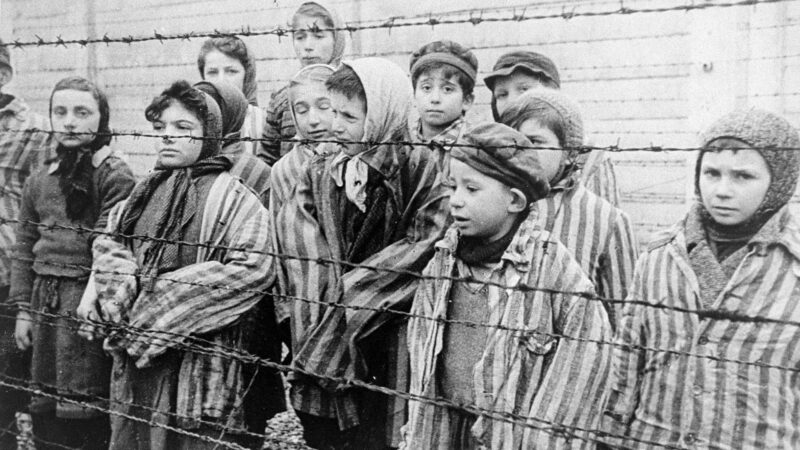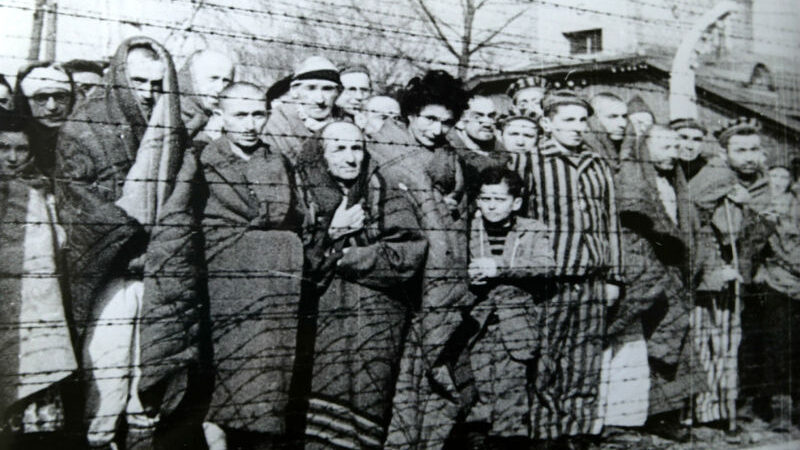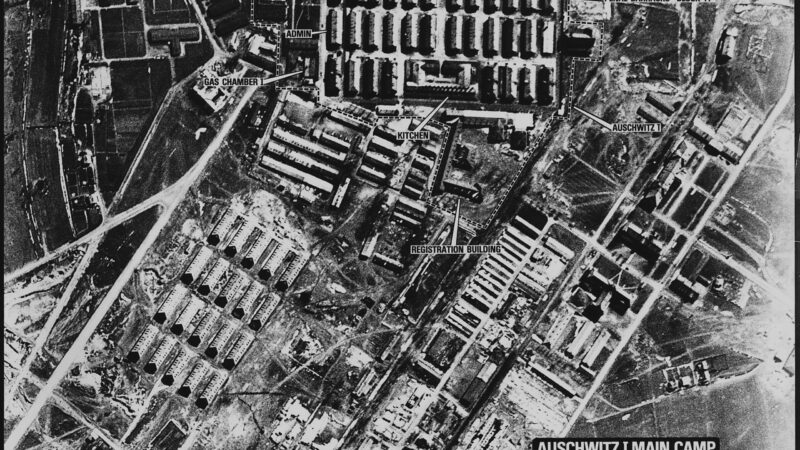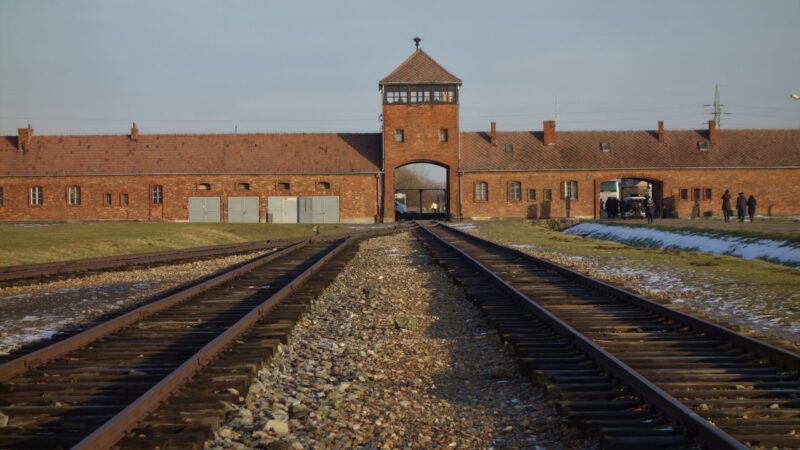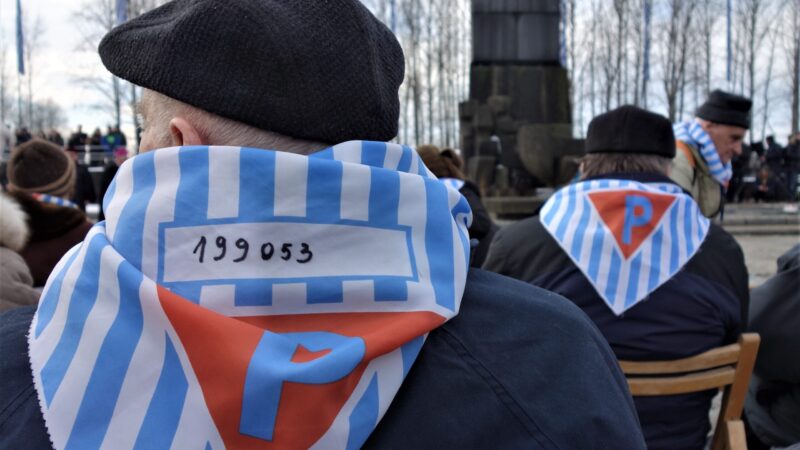International Holocaust Remembrance Day
Children saved from the Auschwitz Camp
KL Auschwitz was the first large concentration camp established by the Germans on occupied Polish territory. Work on its launch began in the spring of 1940. Over the course of four years, this place became a “death factory” in which more than one million people died. Since mid-1944, due to the advancing Red Army offensive, the Germans began evacuating the prisoners. On 27 January 1945, soldiers of the 60th Army of the First Ukrainian Front. entered the camp. The prisoners who remained there regained their freedom.
Former Auschwitz prisoners shortly after the liberation of the camp
They could not believe we were alive….
Elimination of traces
The Red Army offensive often took the Germans by surprise. This was the case in mid-January 1945, when its units reached the outskirts of Cracow, the capital of the General Government, and attacked it from the north and north-west. The city was soon occupied. This news spread just as quickly to the surrounding towns. It also reached the city of Auschwitz, which was located on the other side of the border, in the Katowice Regierungsbezirk in the territories incorporated into the Third Reich. Situated on the Soła and Vistula rivers, it had an extensive railroad infrastructure, which created great opportunities for mass transportation of both goods and people. Another advantage was the large area of land in the vicinity of the planned camp, where workshops and industrial plants could be built so that the prisoners could work for the economy of the Third Reich. In the spring of 1940, after an earlier inspection of the area, the Germans began to organise a concentration camp there. It was created on the model of the Dachau Concentration Camp already functioning in the Reich. The so-called stammlager, or main camp (Auschwitz I), was established on the site of abandoned artillery barracks and the existing brick buildings were converted. In mid-June 1940, the first transport of prisoners arrived at the camp, the so-called political prisoners, from a prison in Tarnów. Over the next two years, the Germans built subsequent parts of the camp: Auschwitz II-Birkenau and the Auschwitz III-Monowitz factory complex. About forty sub-camps were established in nearby towns.
Aerial photo: Auschwitz concentration camp complex 1944
The news about the occupation of Cracow by the Red Army also reached the Auschwitz Concentration Camp, accelerating the evacuation of both the staff and prisoners who were still there. Following the situation on the front, the Germans were aware of the Red Army’s movements, but sometimes the speed of its actions made it necessary to speed up the decisions on evacuation. This introduced chaos. In the following days, until 21 January, members of the camp garrison gathered and led out of Auschwitz-Birkenau more than 50 thousand prisoners. Emaciated, badly dressed, often without outer garments or shoes, without food, they set off on foot in columns deep into the Reich, to other places of imprisonment. They were forced to walk approx. 20-30 km each day, in snow and hard frost. Any attempt to move away from the column was severely punished. Many of the prisoners died during these “death marches.” Apart from evacuating people, the Germans tried to eliminate the traces of their crimes. Camp documentation was destroyed and burned, including rolls of film and photographs of prisoners. Some of the materials were taken with them as they followed the prisoners out. A special SS unit tasked with concealing evidence of genocide blew up the crematorium and gas chamber buildings located in Birkenau. This happened literally hours before the entry of the Red Army.
Deathly silence
Entrance gate to Auschwitz II-Birkenau Concentration Camp. Photo from WGM collection
On a frosty Saturday morning, 27 January 1945, soldiers of the 60th Army of the First Ukrainian Front arrived at the Auschwitz III-Monowitz camp. The area around the buildings was empty. It was not until they were in the hospital barracks that they encountered a group of prisoners. This was the beginning of the discovery of both the size of the entire camp complex and the scale of the crimes committed there. In the afternoon, the Red Army soldiers found themselves in the Auschwitz I and Auschwitz II-Birkenau camp zones. They encountered groups of retreating Germans. A struggle ensued. Both sides suffered losses. However, eventually the Germans were driven out.
As reported by witnesses, at approximately 3.00 PM, the first Red Army scouts entered the Auschwitz I camp. They were greeted by silence and the wind rushing between the barracks. In time, the first of the prisoners still remaining there showed themselves. They looked like human shadows, emaciated, poorly dressed, afraid that the Germans might be coming back. They hid inside the barracks, just in case, squeezed into nooks and crannies so as not to be too conspicuous. They sensed that the end of the war was approaching and with it the end of the ordeal of war they experienced every day in the camp. Prisoners hid in barracks for fear of losing their lives in those final moments. Going deeper into the camp, looking into successive barracks, the soldiers encountered single people; with time, whole groups appeared. When the prisoners realized that the Germans were gone and would not return, enthusiasm and gratitude for rescue arose in those physically stronger. However, many of them were so weak and sickly that they could not even move. Approx. 7 thousand people survived to see the end of the war in the whole camp, although some of them died in the following days. Among the survivors was prisoner Zofia Jankowska-Palińska, who recalled the first reaction of the Red Army when they saw the prisoners as follows: “They all looked at us from a distance and with a strange look on their faces – they could not believe that we were alive”. In her account, the woman also stressed that in the following days the camp site became a place where local residents came to see with their own eyes what happened there during the war, as well as to look for their loved ones.
Shortly after the camp was occupied by the Red Army soldiers, film crews also arrived there. Among them was Polish photographer and cameraman Adolf Forbert. Earlier, in the summer of 1944, it was he who documented similar scenes on the grounds of Lublin (Majdanek) camp. From his short stay at Auschwitz, he remembered “rows of abandoned barracks, limbs of the dead sticking out of snowbanks, and deathly silence all around”. Forbert wanted to document as much as possible, to show the prisoners who were still in the camp and record their appearance and state of health, but also to point out the crimes committed there, the most telling evidence of which was the corpses lying everywhere. Lack of appropriate equipment prevented him from photographing all important places, such as the interiors of the barracks. Unfortunately, the documentation he was able to produce has been lost. The Camp Liberation Chronicle shown today is a documentary film made two weeks after the Red Army entered the Auschwitz-Birkenau camp. Therefore, it is not an original record of the events of 27 January 1945 but a reconstruction of sorts.
Never again? Never again!
Former Auschwitz prisoners in front of the International Monument to the Victims of the Camp on the grounds of Auschwitz II-Birkenau. Photo from WGM collection
Sixty years after these events, in November 2005, the United Nations General Assembly established the International Holocaust Remembrance Day. The date of these ceremonies is 27 January – the anniversary of the liberation of Auschwitz Concentration Camp – the place where the Germans murdered approximately 1.1 million people, including approx. a million Jews. In this way, not only their memory was honoured but also the memory of all other Jews murdered during World War II. The memory of those who died in other death, concentration or forced labour camps, or in mass shootings carried out by the Einsatzgruppen in the east; of those who died of hunger and diseases in the ghettos, and who fell victim to massacres, blackmail and denunciation. Behind the overwhelming number of nearly 6 million murdered European Jews lies the drama of every single person whose fate contributed to this tragic statistic of genocide. The fate of women, men, children. In establishing the International Holocaust Remembrance Day, the UN resolution also called for Holocaust education to prevent and counter genocide, among other things. In this context, it is also important to create new exhibitions and places aimed at showing the history of the Holocaust and commemorating it.
On the occasion of successive important anniversaries related to the Holocaust, the slogan “Never again!” is repeated. It is connected, among other things, with how some Holocaust survivors viewed their mission after the war, trying to recount their tragic experiences and warn against reproducing the mechanisms that led to genocide. Many philosophers, theologians, sociologists, and historians recognise the Holocaust as a unique event in the history of humanity. However, this does not mean that similar crimes cannot happen again. And although the memory of the Holocaust, its causes, course and tragic consequences of dividing people into different categories – valuable and “worthless”, is upheld, discrimination, persecution of entire ethnic or religious groups, as well as mass crimes still occur in the world. The memory of the Holocaust cannot be focused solely on the past – it must be a warning against passivity and indifference to human harm, injustice, and evil. For “Auschwitz did not fall from the sky,” as Holocaust survivor Marian Turski said on 27 January 2020 during the commemoration of another anniversary of the liberation of the camp…
dr Martyna Grądzka-Rejak,
Head of the Research and Science Department of the Warsaw Ghetto Museum
WE COLLECT, WE BUILD, WE REMEMBER
video clip: https://www.youtube.com/watch?v=w4ltJdSfWIs
We are looking for Witnesses to share their story with us. We collect everyday objects, crafts, artwork, documents, and photographs. We are creating a permanent exhibition at the Warsaw Ghetto Museum. For this reason, we need personal documents: letters, postcards, certificates, identity cards, diaries, photographs, photo albums; administrative documents, as well as books, posters, flyers, placards, programs, brochures, etc. We are also looking for a variety of objects, from home furnishings (furniture, dishes, or toys) to elements of street infrastructure (signs, plaques, and means of transportation). We value all everyday items, objects of religious worship and works of art, including contemporary ones, inspired by this tragic chapter of history. The permanent exhibition of the Warsaw Ghetto Museum will be located in the former Bersohn and Bauman Children’s Hospital, at ul. Sienna 60 in Warsaw.
We look forward to seeing you
www.1943.pl/zbiory
zbiory@1943.pl
Telephone No. 22 419 92 50


